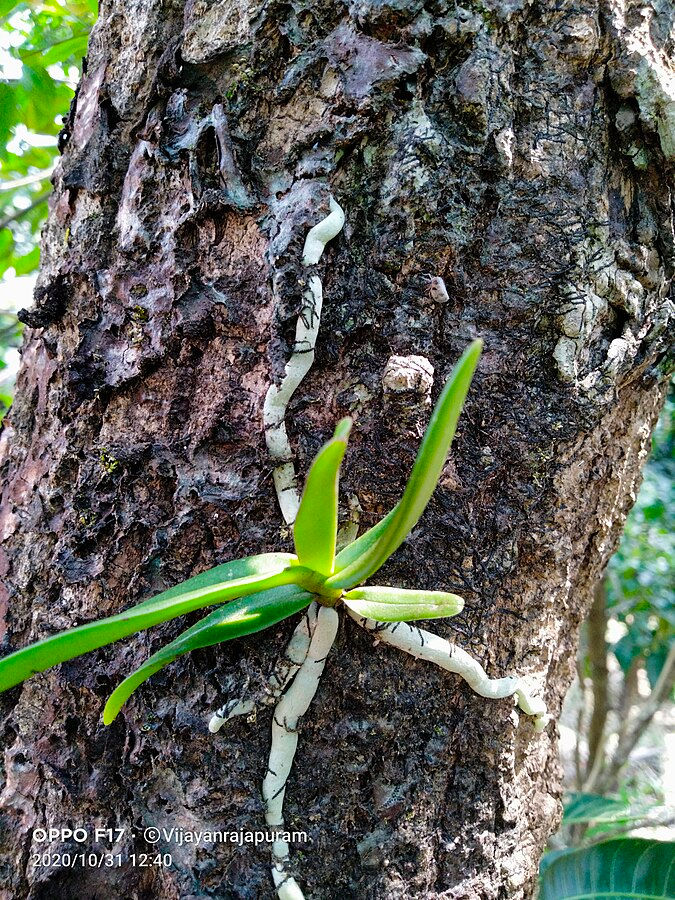More than a flashy flower
- Destiny Davis
- Dec 4, 2023
- 3 min read
(Adapted from a blog post originally written for the USBG)
When it comes to orchids, the showy and sometimes fragrant blooms usually gain the most attention. Making up one of the largest plant families (over 28,000 species!), orchids come in a wide range of colors, shapes, and sizes of blooms. But it’s the roots that provide the essential nutrients and water for the orchid to bloom. Orchid roots provide more functions than just those core needs. From enabling life without soil to digesting fungi, there’s a lot going on down in the roots of orchids.
Orchids can be divided into groups depending on how they grow: in the ground (terrestrial), on rocks (lithophytic), or attached to other plants such as trees (epiphytic).

In nature, you might find epiphytic orchids nestled between tree branches or on limbs with their aerial roots dangling below or gripping tree bark. Because aerial roots are exposed to the air, they use slightly different mechanisms than terrestrial roots to capture and retain moisture.
You’ve probably seen with epiphytic orchids, even if you didn’t know it. About 70% of orchid species are epiphytic, and similarly, most cultivated orchids you might find at plant nurseries or grocery stores are this type that does not grow in soil. (Take a poke at the potting mixture of your orchid. Epiphytic orchids frequently are sold in a mixture of bark and charcoal that allows air to move around the roots instead of soil that would suffocate them.)
Aerial Power
If you take a closer look at epiphytic orchid roots, you might notice a pale green or white layer covering everything but the root tip. This spongey outer layer of dead cells, called velamen, is an important adaptation of epiphytic orchids in particular, since their aerial roots must get all of their water and nutrients from rainfall and excess water dripping off plants above them. While both terrestrial and epiphytic orchid roots can have a velamen layer, the velamen of air-dwelling orchids is usually thicker and spongier so it can retain more water, giving the root more time to absorb water and nutrients.

The green color of aerial roots is also unique. While most plants perform photosynthesis in their leaves, epiphytic orchids can also use their roots to capture energy from the sun. These roots contain the light-harvesting chlorophyll that is typically only found in leaves and stems. Terrestrial orchid roots also provide food to the plant, but not through photosynthesis.
Fungus Life
Orchids have a very close association with fungi. In this symbiotic relationship, fungi called mycorrhizae infect orchid roots and provide essential nutrients to the plant. Orchids attract and digest fungi to supplement photosynthesis—particularly useful when light on the forest floor is scarce. Dependence on fungi varies between species and life stage. Orchid seed germination and early growth depends almost entirely on their mycorrhizae partners. Some orchids have even evolved to grow without any leaves and rely on mycorrhizal fungi for much of their carbon, an essential nutrient.
The essential relationship between orchids and mycorrhizae also presents a unique challenge in orchid conservation in that preserving and saving rare and endangered orchid species often requires preserving and saving their fungal partners as well. These complex inter-kingdom relationships also make orchids particularly vulnerable to habitat change, since orchid survival depends on the survival of their sometimes very specific fungal partners.
In addition to protecting the mycorrhizal association, conserving orchids requires understanding a myriad of other complex relationships including their habitat structure, biogeography, and the forest ecology of where they live. A key focus of a team of interdisciplinary researchers and the North American Orchid Conservation Center (NAOCC), a collaborative organization founded in 2010 by the U.S. Botanic Garden and the Smithsonian Institution, is to understand unique orchid ecology with the aim to contribute to orchid conservation.
Nationally, efforts through NAOCC are focused on developing effective propagation protocols for North American orchid restoration and establishing and safeguarding orchid seed and fungal collections. The hope is that these national and international research projects will lead to the conservation of the more than 200 orchid species native to the United States and North America–the primary objective of NAOCC’s work.
Terrestrial U.S. Native Orchids
Most of the 200+ orchid species that grow in the wild in the United States are terrestrial and grow in a variety of environments including wetlands, forests, and even prairies. U.S. native orchids can be found in every state. To find which native orchids might be in your backyard, you can search the North American Orchid Conservation Center’s database.

At your next visit to your nearest botanic garden or orchid house, be sure to look above and below and see if you can find the different types of roots. Look for velamen with its unique color, and green synthetic roots that might be hanging or clinging to a tree branch. Think about the unique features of orchid roots, including their microscopic dependence on mycorrhizal fungi, and their role in supporting the wide variety of orchid species.
Resources for more information:


Comments